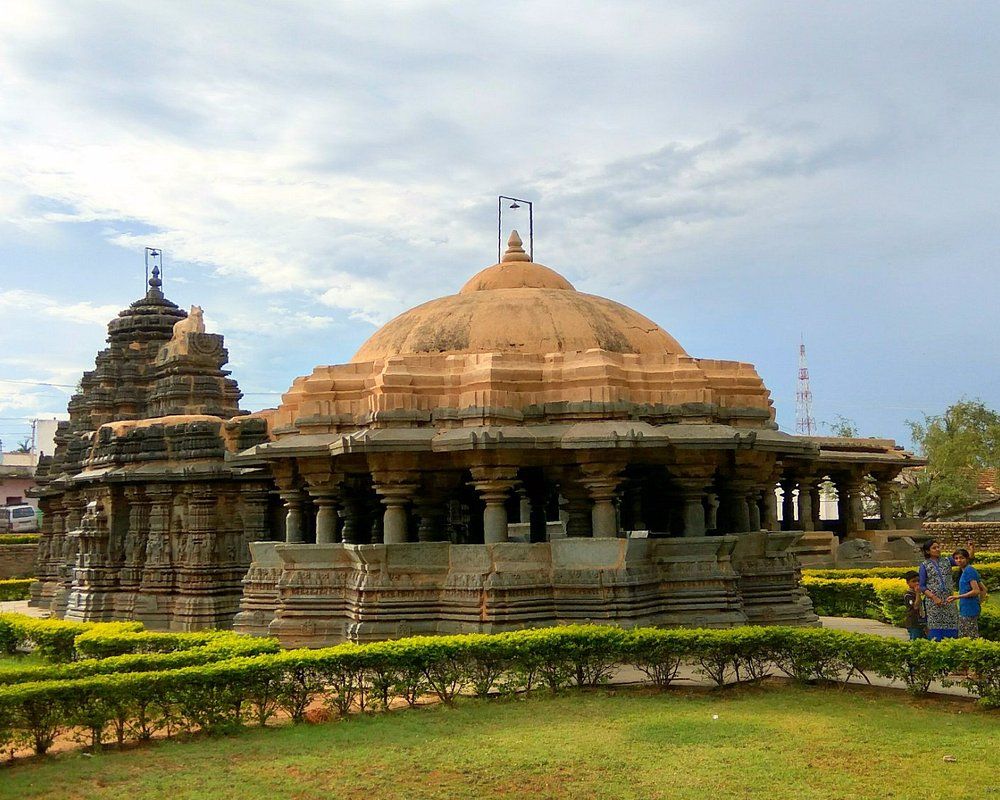Ishvara Temple, Arasikere
Ishvara Temple, Arsikere: A Masterpiece of Early Hoysala Architecture

The Ishvara temple, also referred to as the Ishwara or Isvara temple, is an early 13th-century Hindu temple in Arsikere, Hassan district, Karnataka India. Dedicated to Shiva, it stands as one of the most notable early Hoysala architecture examples, featuring a rotating circular plan, a domed mandapa with a 16-point star shape, a pancatala vimana, and a rich array of artwork depicting Shaivism, Vaishnavism, Shaktism, and Vedic legends of Hinduism.[1][2]
The Ishvara temple was part of a larger complex of Hindu temples in Arasikere. Tragically, most of these temples and their artwork faced destruction and mutilation in or after the 14th century. Alongside the Ishvara temple, a simpler and more damaged double temple (Shivalaya) survives immediately to its north within the current compound, distinguished by its red-stone pillars. Approximately 200 meters southwest of the Ishvara temple lies the Sahasrakuta Jinalaya – a ruined and mutilated monument of Jainism.[3]
The Ishvara temple is protected as a monument of national importance by the Archaeological Survey of India.[4]
Location and Date
Arasikere, also referred to as Arsikere or Arsiyakere in historic Indian texts, is situated about 41 kilometres (25 mi) east of Hassan city and approximately 140 kilometres (87 mi) north of Mysuru city. It lies at the southwestern edge of the Nagapuri forest and hills, with connectivity to India's national highway network via NH 73. The Isvara temple is located on the northeastern side of the town. Arasikere (literally "Queens tank") derives its name from Arasi meaning "queen" or "princess" and kere meaning "tank" in the Kannada language.[5]
While the temple has several inscribed stones and hero stones, none provide direct foundation information to precisely date its construction. However, based on references within these available inscriptions, the temple must have been in existence during the reign of Narasimha II of the Hoysala dynasty, by approximately 1220 CE.[2] Furthermore, these inscriptions suggest that the Ishvara temple was part of a much larger complex, and that the Shiva linga inside this temple was referred to as Kattamesvara. The temples remained active until the early 14th century, evidenced by mentions of gifts and donations in the inscriptions. A survey conducted in 1918 by a team of British and Indian archaeologists documented another inscription – Arsikere Inscription #84 – which helps establish that the double temple to the left of the Ishvara temple also existed by 1220 CE. The survey team also reported witnessing numerous mutilated figures of Durga, Ganesha, Mahisasuramardini, and others, as well as scattered sections of "some temple which is no longer in existence".[3]
Architecture
The Vimana and ranga-mandapa walls of the Isvara temple
The Ishvara temple was constructed using soapstone.[6] Despite its modest size, it exhibits sophisticated architecture characterized by its ground plan: a 16-point star-shaped mantapa (hall) and a stellate shrine with distinct corners.[1][7] According to Dhaky, a renowned scholar of temple architecture and history, the temple "ranks among the most notable of the Hoysala times".[2] Foekema describes it as "exceptionally intricate".[8]
The temple faces east. It features an open navaranga and a mukha-mantapa with a round dome on top, likely once adorned with a seated Nandi (now missing). This open mandapa is supported by 21 pillars, with 8 towards the middle exhibiting decoration, while the outer 13 pillars each have a pair of elephants near their base.[3] A square outer porch is present.[3] The open mantapa (hall) has a deep concentric joist-and-rafter ceiling with an inverted lotus, which Dhaky notes is crafted to successfully simulate a timber appearance.[2] The architect thoughtfully included an integrated stone bench along the sides of the open mandapa for pilgrims to gather and rest.[8] Inside lies another closed gudha-mantapa.[9] The gudha-mantapa is a 20 feet by 20 feet square.[2] Its ceiling is supported by four lathe-turned pillars.[8]
The square sanctum (garbhagriha) enshrines a Shiva linga. Its doorway is beautifully carved with five sakhas featuring scrolls, geometric patterns, and standing lions. The lintel (lalitabimba) depicts Gajalakshmi. Above it is a panel showcasing (from left to right): Vishnu, Kartikeya (also known as Subramanyam, Murugan, Skanda), Shiva in the middle flanked by lions, Ganesha, and Brahma.[3] The sukhanasi above the sanctum features a Nataraja (Tandavesvara) with musicians nearby.[3] The vimana has five storeys (pancatalas). It is based on a rotating circular plan with two pallavis – bifacial-equilateral and stellate – which together create the dramatic and charming symmetry of the superstructure, according to Dhaky.[2] The jangha section below is flanked by kuta-stambhas and contains Hindu deities. This scheme wraps around the walls of the gudha-mantapa, enhancing the temple's visual aesthetics. The reliefs therein include various forms of Shiva, the Saptamatrikas (seven mother goddesses), the avatars of Vishnu, Ganesha, Surya, Parvati, Lakshmi, and Sarasvati – thus presenting a galaxy of Hindu legends and traditions.[2] The walls display a total of 120 reliefs, with 62 female and 58 male figures.[3]
Rear view of the Ishvara temple at Arasikere
The outer wall of the vestibule shares the same decoration as the outer wall of the shrine but is less conspicuous due to its short continuation between the shrine wall and that of the closed mantapa.[8] The outer wall of the shrine is stellate, but the star points are not uniform; rather, they form three different kinds of star points, resulting in a complex and unusual design.[9] The lower half of the outer wall of the shrine and the outer wall of the closed mantapa share the same architectural articulation. The open hall, with its 16-pointed star plan, is particularly unusual. The central ceiling in the closed mantapa and the vestibule are elaborately decorated.[9]
Both the interior and exterior of the temple demonstrate high workmanship. The elegantly decorated ceilings, the domical ceiling of the open mantapa, the sculptures of Dwarapalakas (door keepers) in the closed mantapa (also called navaranga), and the 120 wall panel images (on pilasters between the aedicules – miniature decorative towers) carved on the outer walls are noteworthy, states Foekema.[5]
The temple has undergone some modern-era modifications. For instance, near the Sukhanasi is a stuccoed figure of a seated Nandi made of bricks – not the original material of the temple.[8][2] Typically, one would expect the Hoysala crest instead, but this was likely damaged or destroyed long ago.[3]
Other Monuments
Immediately north of the Ishvara temple stands a double temple with a shared hall. The two sanctums house Shiva lingas, while the hall is supported by 24 red stone pillars featuring 21 ceiling niches, each with a lotus. The double temple exhibits a simpler design and decoration. During the 1918 survey, the hall showed ruined and mutilated sections, including those of Ganesha. Outside, in the field near the temples, were also found mutilated portions of Durga, Vishnu, a dancing Ganapati, Mahisasuramardini, and others.[3] A ruined Jinalaya (Jain temple), the Sahasrakuta Jinalaya, located about 200 meters southwest of the Ishvara temple, contains a mountain icon with 1000 Jinas, hence its name. According to inscriptions, this Jain temple was built around the same time as the Ishvara temple, dating to approximately 1220 CE.[3]
